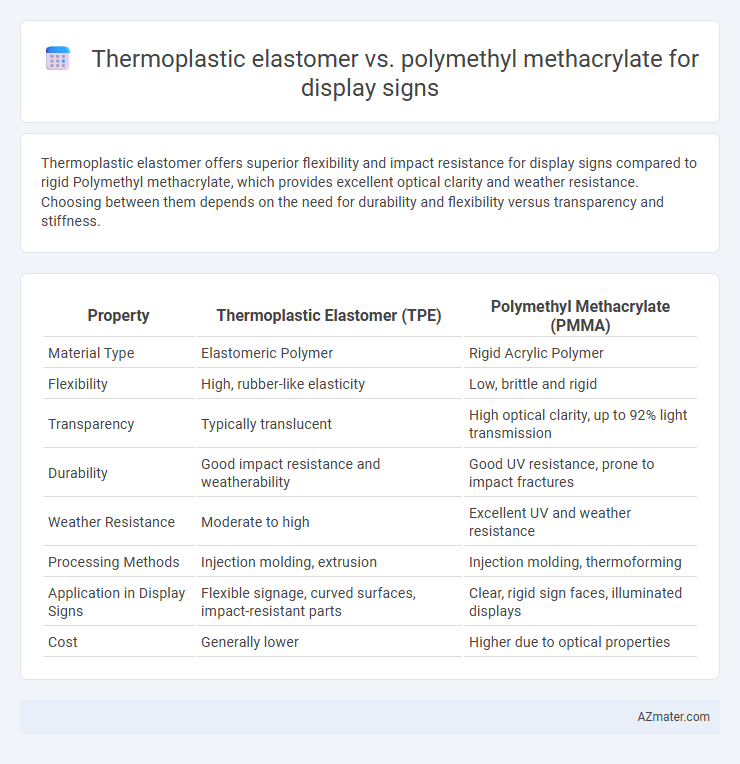Thermoplastic elastomer offers superior flexibility and impact resistance for display signs compared to rigid Polymethyl methacrylate, which provides excellent optical clarity and weather resistance. Choosing between them depends on the need for durability and flexibility versus transparency and stiffness.
Table of Comparison
| Property | Thermoplastic Elastomer (TPE) | Polymethyl Methacrylate (PMMA) |
|---|---|---|
| Material Type | Elastomeric Polymer | Rigid Acrylic Polymer |
| Flexibility | High, rubber-like elasticity | Low, brittle and rigid |
| Transparency | Typically translucent | High optical clarity, up to 92% light transmission |
| Durability | Good impact resistance and weatherability | Good UV resistance, prone to impact fractures |
| Weather Resistance | Moderate to high | Excellent UV and weather resistance |
| Processing Methods | Injection molding, extrusion | Injection molding, thermoforming |
| Application in Display Signs | Flexible signage, curved surfaces, impact-resistant parts | Clear, rigid sign faces, illuminated displays |
| Cost | Generally lower | Higher due to optical properties |
Introduction to Display Sign Materials
Thermoplastic elastomers (TPEs) offer flexibility, impact resistance, and ease of fabrication, making them ideal for dynamic or curved display signs requiring durability and weather resistance. Polymethyl methacrylate (PMMA), known for its excellent optical clarity, UV resistance, and rigidity, is preferred for static display signs demanding high transparency and aesthetic appeal. Selection between TPE and PMMA depends on the display sign's operational environment, desired visual effects, and mechanical performance requirements.
Overview of Thermoplastic Elastomer (TPE)
Thermoplastic elastomer (TPE) offers exceptional flexibility and impact resistance, making it an ideal material for display sign applications requiring durability and resilience. Its rubber-like elasticity combined with the processability of plastics allows for easy molding into various shapes and sizes without compromising structural integrity. TPE's weather resistance and UV stability ensure long-lasting performance in outdoor signage compared to rigid materials like polymethyl methacrylate (PMMA).
Overview of Polymethyl Methacrylate (PMMA)
Polymethyl methacrylate (PMMA) is a transparent thermoplastic commonly used in display signs due to its excellent optical clarity, high weather resistance, and UV stability. Its rigidity and hardness make it ideal for outdoor signage where durability and resistance to scratching are crucial. PMMA offers superior light transmittance of approximately 92%, outperforming many other plastics, ensuring bright and vivid displays in various lighting conditions.
Mechanical Properties: TPE vs PMMA
Thermoplastic elastomers (TPE) offer superior flexibility, impact resistance, and elongation compared to polymethyl methacrylate (PMMA), making them ideal for dynamic display signs requiring durability under stress. PMMA exhibits higher rigidity, hardness, and excellent optical clarity but is more prone to cracking under mechanical impact. The choice between TPE and PMMA depends on whether flexibility and impact absorption or stiffness and transparency are prioritized in display sign applications.
Optical Clarity and Light Transmission
Thermoplastic elastomers (TPE) offer moderate optical clarity and light transmission, making them suitable for flexible or impact-resistant display signs but less ideal for applications requiring crystal-clear visuals. Polymethyl methacrylate (PMMA) excels in optical clarity with light transmission levels up to 92%, surpassing many plastics, which provides superior transparency for display signs requiring sharp, vibrant visuals. Choosing PMMA ensures maximum brightness and clarity, while TPE provides durability with lesser optical performance.
Durability and Weather Resistance
Thermoplastic elastomers (TPE) offer superior flexibility and impact resistance for display signs, maintaining structural integrity under varying weather conditions such as UV exposure and temperature fluctuations. Polymethyl methacrylate (PMMA), while providing excellent clarity and rigidity, is more susceptible to cracking and yellowing over time when exposed to harsh outdoor environments. For long-term durability and weather resistance, TPE materials generally outperform PMMA in demanding signage applications.
Flexibility and Formability
Thermoplastic elastomers (TPE) offer superior flexibility and excellent formability, making them ideal for display signs that require bending or shaping without cracking. Polymethyl methacrylate (PMMA), while rigid and providing a high-gloss finish, lacks the flexibility necessary for intricate or curved designs and is more prone to breaking under stress. For applications prioritizing durability with dynamic shapes, TPE outperforms PMMA in flexibility and ease of thermoforming.
Cost-effectiveness and Availability
Thermoplastic elastomers (TPE) offer superior cost-effectiveness for display signs due to their lower raw material costs and ease of fabrication, ideal for budget-conscious projects. Polymethyl methacrylate (PMMA), while more expensive, provides excellent optical clarity and UV resistance, often necessitating higher initial investment and procurement efforts. Availability of TPE is generally more widespread with diverse suppliers, whereas PMMA sourcing can be limited depending on grade and quality requirements.
Application Suitability for Display Signs
Thermoplastic elastomers (TPE) offer superior flexibility and impact resistance, making them ideal for display signs requiring durability and frequent handling. Polymethyl methacrylate (PMMA), known for its exceptional clarity and weather resistance, is preferred for high-visibility signs exposed to outdoor environments. TPE's elasticity supports dynamic, tactile displays, whereas PMMA's rigidity ensures sharp visual appeal and long-lasting UV stability.
Conclusion: Choosing Between TPE and PMMA
Thermoplastic elastomer (TPE) offers superior flexibility, impact resistance, and weatherability, making it ideal for display signs requiring durability and adaptability in outdoor environments. Polymethyl methacrylate (PMMA), known for its excellent optical clarity and UV resistance, is preferred for signs where transparency and a polished aesthetic are critical. Selecting between TPE and PMMA depends on whether the primary need is for robust, flexible signage or clear, high-quality visual presentation.

Infographic: Thermoplastic elastomer vs Polymethyl methacrylate for Display sign
 azmater.com
azmater.com